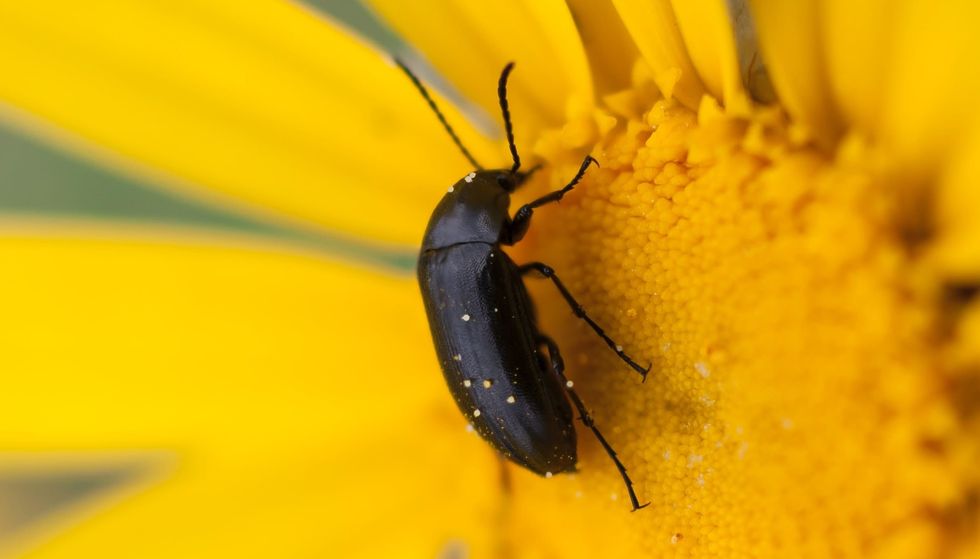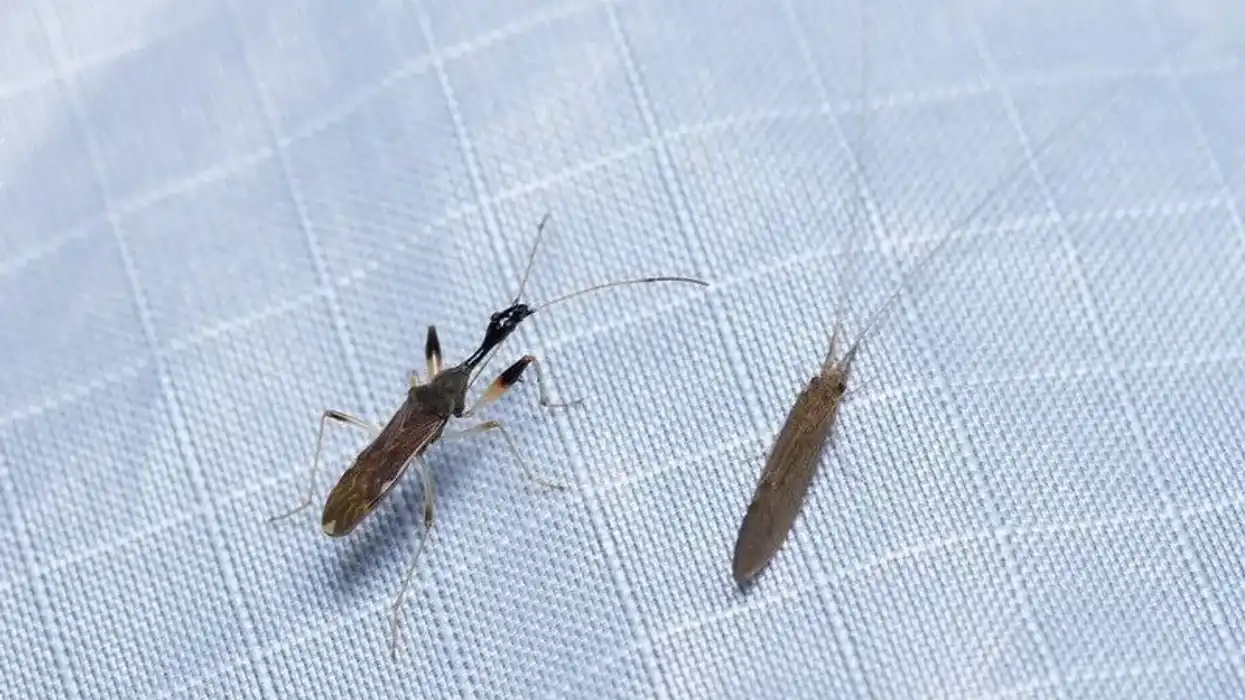The cane beetle (Dermolepida albohirtum), also known as gray back cane beetle, is a species of pests of sugarcane plants native to Australia. The cane beetles feed during the night and are nocturnal.
The cane beetle grub feeds on the roots of the sugarcane plant and deals significant damage in the process. The adult prefers feeding on the leaves of the sugarcane crops. This beetle can live a life of about one year.
The cane beetle has a hard shell body that is light gray or white with black spotting. They have black eyes a brown or redhead.
The adult cane beetle can lay about 20-30 eggs per clutch. They can have three clutches and lay their eggs near the roots of the tallest sugarcane.
From February to May, the eggs hatch and turn into grubs that feed on roots. There is no specific way to deal with the adult or cane beetle grub. Insecticides are harmful as they can also kill off useful insects.
There are also no biological control efforts or options suitable for Dermolepida albohirtum and is still under research. If you enjoyed reading about the cane beetle, you could also check out the black blister beetle and the tiger beetle.
Cane Beetle Interesting Facts
What type of animal is a cane beetle?
The grayback cane beetle, or Dermolepida albohirtum, is a species of beetle or parasitic insect of sugarcane plant native to Australia.
What class of animal does a cane beetle belong to?
The cane beetle pest belongs to the class of Arthropods and the Dermolepida genus of the Scarabaeidae family. Their scientific name is Dermolepida albohirtum.
How many cane beetle are there in the world?
The current global population of the Australian cane beetle pest is unknown. The temperature of its habitat, rainfall, weather conditions, and solar radiation are some factors that influence the population dynamics of the adults. This makes it difficult to come up with a conclusive number of Dermolepida albohirtum in Australia.
Where does a cane beetle live?
As the name suggests, the grayback cane beetle is a parasite of the sugarcane plant and is found in farms in Australia. They are also found in the Philippines. This beetle is endemic and not found outside of its range.
What is a cane beetle's habitat?
The habitat of cane beetle is mainly in agricultural fields that are full of sugarcanes. The larvae are usually found underground.
Who does cane beetle live with?
Cane beetles are mostly solitary and are only seen together during the breeding season or after the larvae hatch together.
How long does a cane beetle live?
The average life cycle of adult beetles has three-stage and live on for one year.
How do they reproduce?
The female cane beetle is an oviparous insect that lays eggs in the soil after mating. The average depth at which the eggs are laid is around 8-18 in (20 to 45 cm).
Females lay 20-30 eggs every clutch and can have at most three clutches per year. The beetle grub that hatches subsequently feeds on sugarcane roots from early February to May. After it is fully fed in three to four months, it turns into a pupa and starts developing into an adult.
The pupa developed into an adult within a month and emerged from the soil. Dermolepida albohirtum can delay the emerging if the weather above ground is not stable or suitable.
What is their conservation status?
The conservation status of the Australian cane beetle is Not Listed, which means that the population dynamics is currently unknown. As a common agricultural pest, the numbers should be mostly stable and not threatened in any way.
Cane Beetle Fun Facts
What does the cane beetle look like?

*Please note the main image and this image are of a sugarcane beetle that belongs to the same family as the slender cane beetle. If you have an image of a cane bettle please let us know at hello@kidadl.com.
Adult cane beetles are white in color and have small dots of black all over their body. The grubs of this insect are also small and white. They have six legs, black eyes, and a brown or red head.
How cute are they?
The gray back cane beetle looks like an average beetle, and its color pattern is not particularly attractive. Overall, they are not very cute and they damage crops.
How do they communicate?
The cane beetles communicate using chemicals and pheromones. The pheromone system is very advanced, and they can use scents to convey different messages.
How big is a cane beetle?
The average length of a cane beetle adult is about 0.4-0.6 in (10-15 mm). They are about ten times smaller than their predator, cane toads.
How fast can a cane beetle fly?
There are no studies that have estimated the flying speed of cane beetles.
How much does a cane beetle weigh?
The weight of a cane beetle is almost negligible.
What are the male and female names of the species?
There are no specific names for male and female adults.
What would you call a baby cane beetle?
When the egg hatches, the baby beetle is known as a larva. After the larvae stage is the pupa and then finally an adult. The larvae are also known as the cane beetle grub.
What do they eat?
Adult cane beetles mostly rely on leaves of the sugarcane plant in Australia. The grubs are present below the soil surface and feed on the roots of sugarcane and lead to a lot of damage like stunted growth or even death. The main predator of Dermolepida albohirtum species is the ground beetle, ants, and wasps.
Are they dangerous?
Adult beetles are not directly harmful to human beings. The grub that hatches from eggs in the soil attacks the roots of sugarcane plants and fields. The adult beetles feed mostly on the leaves. This may lead to lower productivity of sugarcane, leaf damage, stunted growth, and even death.
The resulting reduced productivity sabotages the quality, which in turn economically affects human beings. Since they live underground, it is difficult to use insecticide as it will also remove useful insects. Biological control of cane beetles is still in development.
Would they make a good pet?
Cane beetles are agricultural pests and would not make a good pet. There have been talks of controlling the species through predators as the beetles can lead to the death of sugarcane plants. If you do notice a cane beetle in your garden, it is best to beware and check your garden for signs of damage.
Did you know...
The cane toad was introduced into Australia in early 1935 from Central America and South America to reduce the population of cane beetle adults.
The introduction of this toad was an attempt to control the population of cane beetles or the French cane beetles.
However, the introduced cane toads are not native to Australia and from a totally different environment of South America. Although the cane toad turned out to be a successful predator, or biological control of the cane beetle, they preferred other food and became an invasive pest themselves.
The cane toad population increased so much that it leads to the decrease of natural native predators such as quolls or marsupial cats and are in need of control measures.
How do beetles help humans?
Beetles, in general, are pollinators of different plants and flowers, which makes their ecosystem role very important. Beetles like the dung beetle can also help in the introduction of nutrients and useful material into the soil when they bury their dung.
They are decomposers in forests and help reduce populations of insects like caterpillars.
The ladybird beetles are predators of aphid pests and are known to hold some commercial value for this reason. The ground beetles can help control the population of weeds by eating the seeds in the soil.
Do cane toads eat cane beetles?
Yes, cane toads do eat cane beetles. However, they prefer other food and have a vast number of potential food sources.
The cane toad looks for food using smell and can even eat dog food! The cane toads have become an invasive pest and have toxins that other native animals are not immune to. Due to the magnanimous diet of this animal, control measures have been issued.
Here at Kidadl, we have carefully created lots of interesting family-friendly animal facts for everyone to discover! Learn more about some other arthropods with our water beetle facts and darkling beetle facts.
You can even occupy yourself at home by coloring on one of our free printable cane beetle coloring pages.









